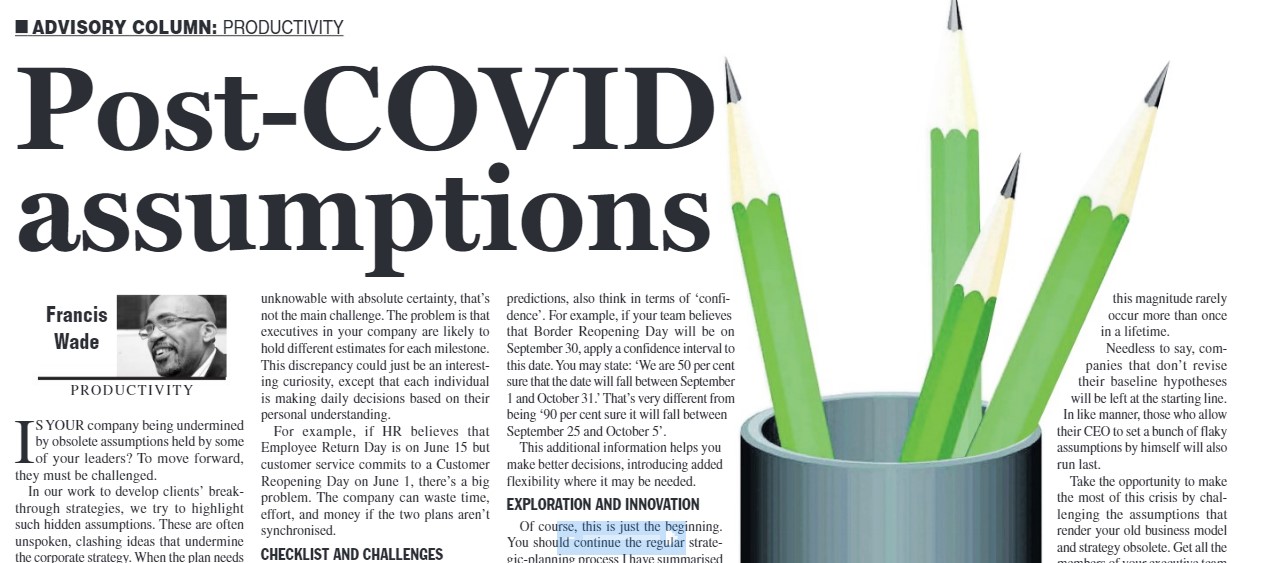Is your company being undermined by obsolete assumptions held by some of your leaders? To move forward, they must be challenged.
In our work to develop clients’ breakthrough strategies, we try to highlight such hidden assumptions. These are often unspoken, clashing ideas which undermine the corporate strategy. When the plan needs revision, the team should uncover and sort out these differences to act as one.
Unfortunately, most companies were rushed to respond to COVID-19 and created little more than a bunch of survival tactics. Now that the lockdown is being phased out, organizations must find a way to achieve their “new normal” if they hope to thrive.
However, as they do so, they need to look past the relatively simple task of putting people back in front of their desks safely. A fresh strategy is required to suit the times. One approach is to explore the foundation assumptions which are now embedded in their old business model. For example, they should date the following common, future milestones.
- New Coronovirus Case Level-Off Day
- Active Case Reduction Day
- Curfew Lifting Day
- Employee Separation Day
- Remaining Employee Return Day
- Customer Re-Opening Day
- Border Re-Opening Day
- International Flight Resumption Day
- End of Social Distancing Day
- Ro Below 1.0 Day (A measure of COVID-19’s contagiousness.)
Each of these public events signals a turning point in the crisis. While they are unknowable with absolute certainty, that’s not the main challenge. The problem is that executives in your company are likely to hold different estimates for each milestone. This discrepancy could just be an interesting curiosity, except that each individual is making daily decisions based on their personal understanding.
For example, if HR believes that Employee Return Day is on June 15th, but Customer Service commits to a Customer Re-Opening Day on June 1st, there’s a big problem. The company can waste time, effort and money if the two plans aren’t synchronized.
But this list of key dates is just a start. There are a number of other assumptions which only apply to your industry, or company which need to be unearthed. Here are some of the questions I have been urging clients to ask themselves.
Q1 – What material changes have occurred in our business? Here, I recommend you brainstorm individually and then as a team. It’s no place for group-think – the tendency for people to conform to majority thinking. Focus on concrete changes which are tangible and can be measured.
Q2 – Why does the change matter? Here you must confront aspects of your business model which can no longer work. Query what will happen if you continue the old model in this new environment.
Q3 – If the change is permanent, what were the original assumptions that must be challenged? These were embedded in the old business model, perhaps never discussed. Now, you must make them explicit.
Q4 – What are the new assumptions? Given the data you have on hand, what will you assume moving forward?
Furthermore, to make sense of your predictions, also think in terms of “confidence”. For example, if your team believes that Border Re-Opening Day will be on September 30th, apply a confidence interval to this date. You may state: “We are 50% sure that the date will fall between September 1st and October 31st.” That’s very different from being “90% sure it will fall between September 25th and October 5th. “
This additional information helps you make better decisions, introducing added flexibility where it may be needed. Of course, this is just the beginning. You should continue the regular strategic planning process I have summarized in prior articles:
- Create a current snapshot
- Set a target month/year that will allow a breakthrough to manifest
- Craft measurable outcomes
- Backcast from the future to 2020, filling the gap with necessary actions and milestones
- Finally, ensure that the context of the discussion is one of exploration and innovation. The fact is, there will probably never be another moment like this in your business. Discontinuities of this magnitude rarely occur more than once in a lifetime.
Needless to say, companies that don’t revise their baseline hypotheses will be left at the starting line. In like manner, those who allow their CEO to set a bunch of flaky assumptions by himself will also run last.
Take the opportunity to make the most of this crisis by challenging the assumptions that render your old business model and strategy obsolete. Get all the members of your executive team talking to arrive at a new baseline.
Feels uncomfortable? The fact is that you are making an educated guess, then taking a bet that you are right. Regardless, your organization needs you to make such commitments so it can find success within this pandemic.
http://jamaica-gleaner.com/article/business/20200516/francis-wade-post-covid-assumptions

